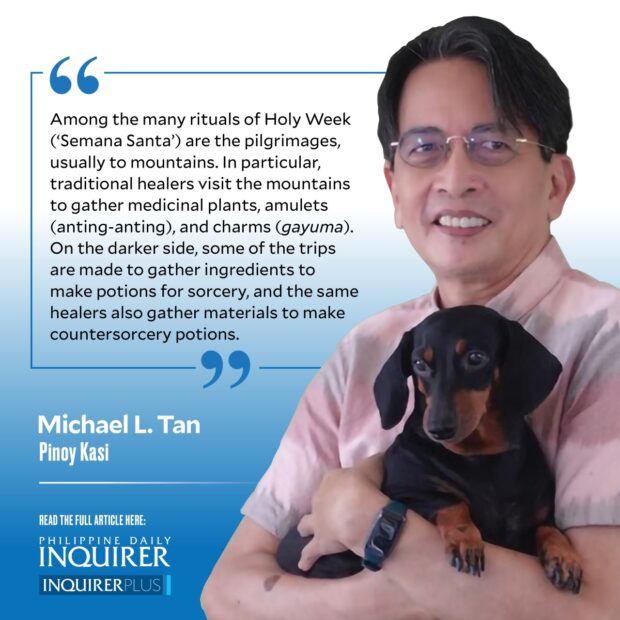
The more popular destinations for these medicinal plants pilgrimages are Mount Banahaw and Siquijor, the latter having become a tourist come-on with a government-sponsored Healing Festival. Banahaw, on the other hand, because it was a popular pilgrimage site all year round because of the Rizalista cults and their many puestos (sacred places), is now considered a protected zone with restrictions on travel to certain areas because of all the garbage and environmental destruction caused by the visitors.
The rationale behind the Holy Week medicinal plants gathering is that the entire Lent (Cuaresma) and much more so during Semana Santa, is a sacred time, imbued with power because of Christ’s sacrifices for humanity. A more modern metaphor of “recharging” is used to describe this sacred time, the natural environment yielding powerful objects. Good Friday is the most powerful day of Lent, a time used for “cooking” (pagluluto) the medicinal preparations and amulets, talismans, charms … and objects for sorcery.
I’ve been thinking we might want to think of ways to make Lent and Holy Week a time for healing. I thought about this because of the University of the Philippines’ academic calendar, where a “recharging week” is scheduled, depending on the campus, either before or after Holy Week. In effect, students get two weeks off and I know most of them are going to use it for sun, sand, and surf. I did tell my classes that was all right but still asked that they consider more reflective or mindful activities as part of their recharging.
The timing could not have been more perfect, Holy Week coming around the middle of the second semester of a hectic academic year, made worse by the summer heat that is truly penitential for humans, our nonhuman friends, and the plants.
As we try to alleviate our suffering, we should not forget those who are in even greater need, struggling with illnesses especially chronic and end-of-life conditions, and with recent bereavement, still quite common even with COVID retreating.
Consider visiting friends and relatives going through a difficult time. But I do want to appeal to readers not to transform the visits into additional penitence. Some people love visitors but many of the elderly, especially those with serious dementia, find the visits to be taxing.
The essence of the visit is presence, where even silence is comforting. When my mother was in her final years of dementia, I had to end up filtering visitors, asking caregivers to request short visits, and even turning away some visitors notorious for wanting to “convert” my mother to their religions or to conduct pray-overs, which always turned off my mother.
Gifts are optional with the visits but here’s an idea. The Inquirer recently had an article about singer Ebe Dancel describing how he was missing a “comfort cross” he lost while moving house.
I knew exactly what he was referring to because last Christmas, when a dying uncle asked me for a religious calendar, I ended up in the SVD (Divine Word Missionaries) shop on E. Rodriguez where I did find several calendars and a wooden cross that at first seemed strange because it was asymmetrical. I held one in my hands and found it had a very comforting fit.
I looked up the cross on the internet and learned all about holding crosses, intended to bring comfort to the lonely, the sick, the dying, and people dealing with fears, for example, while traveling. Prayer is optional because merely holding it is a form of mindfulness.
I was also able to find a local maker: the Focolare group has shops in Antipolo and Tagaytay. Shopee and Lazada also carry them, all variations but the simpler ones are the most appealing.
Whether your visits are this Holy Week or not, whether it’s with holding cross or not, it’s your presence, your connecting that can become healing.
mtan@inquirer.com.ph

